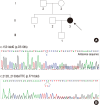The significance of clinical and laboratory features in the diagnosis of glycogen storage disease type v: a case report
- PMID: 25045239
- PMCID: PMC4101771
- DOI: 10.3346/jkms.2014.29.7.1021
The significance of clinical and laboratory features in the diagnosis of glycogen storage disease type v: a case report
Abstract
Glycogen storage disease type V (GSD-V) is the most common disorder of muscle glycogenosis with characteristic clinical and laboratory findings. A 32-yr-old woman complained of exercise intolerance and myoglobulinuria since early adolescence. She reported several episodes of second-wind phenomenon. Physical examination did not show any neurological abnormality, including fixed muscle weakness or atrophy. Serum creatine kinase level was 1,161 IU/L at rest. The result of the non-ischemic forearm exercise test was compatible with GSD-V. Mutation analysis identified the compound heterozygous mutations of the PYGM, p.D510fs and p.F710del, which has not yet been reported in Korea. The present case recognizes that detail clinical and laboratory analysis is the first step in the diagnosis of GSD-V.
Keywords: Glycogen Storage Disease Type V; McArdle's Disease; Phosphorylase, Glycogen, Muscle (PYGM).
Figures


Similar articles
-
Diagnosis and genetic analysis of a case with glycogen storage disease type V caused by compound heterozygous mutations in the PYGM gene.Yi Chuan. 2022 Nov 20;44(11):1063-1071. doi: 10.16288/j.yczz.22-223. Yi Chuan. 2022. PMID: 36384998
-
A novel compound heterozygous mutation in PYGM gene associated with McArdle's disease.Acta Myol. 2022 Mar 31;41(1):37-40. doi: 10.36185/2532-1900-067. eCollection 2022 Mar. Acta Myol. 2022. PMID: 35465342 Free PMC article.
-
[Late diagnosis of a McArdle disease's case (type V glycogenosis)].Ann Biol Clin (Paris). 2007 Sep-Oct;65(5):550-4. Ann Biol Clin (Paris). 2007. PMID: 17913675 French.
-
McArdle disease: molecular genetic update.Acta Myol. 2007 Jul;26(1):53-7. Acta Myol. 2007. PMID: 17915571 Free PMC article. Review.
-
McArdle Disease: Update of Reported Mutations and Polymorphisms in the PYGM Gene.Hum Mutat. 2015 Jul;36(7):669-78. doi: 10.1002/humu.22806. Epub 2015 Jun 3. Hum Mutat. 2015. PMID: 25914343 Review.
Cited by
-
McArdle's Disease: A Differential Diagnosis of Metabolic Myopathies.Cureus. 2024 Sep 23;16(9):e70000. doi: 10.7759/cureus.70000. eCollection 2024 Sep. Cureus. 2024. PMID: 39318660 Free PMC article. Review.
-
Recurrent Episodes of Rhabdomyolysis after Seizures in a Patient with Glycogen Storage Disease Type V.J Clin Neurol. 2016 Jul;12(3):373-5. doi: 10.3988/jcn.2016.12.3.373. Epub 2016 Jun 3. J Clin Neurol. 2016. PMID: 27273923 Free PMC article. No abstract available.
-
Novel Asp511Thr mutation in McArdle disease with acute kidney injury caused by rhabdomyolysis.CEN Case Rep. 2019 Aug;8(3):194-199. doi: 10.1007/s13730-019-00392-6. Epub 2019 Mar 21. CEN Case Rep. 2019. PMID: 30900170 Free PMC article.
References
-
- Vieitez I, Teijeira S, Fernandez JM, San Millan B, Miranda S, Ortolano S, Louis S, Laforet P, Navarro C. Molecular and clinical study of McArdle's disease in a cohort of 123 European patients: identification of 20 novel mutations. Neuromuscul Disord. 2011;21:817–823. - PubMed
-
- Dimaur S, Andreu AL, Bruno C, Hadjigeorgiou GM. Myophosphorylase deficiency (glycogenosis type V; McArdle disease) Curr Mol Med. 2002;2:189–196. - PubMed
-
- Haller RG. Treatment of McArdle disease. Arch Neurol. 2000;57:923–924. - PubMed
-
- Lucia A, Ruiz JR, Santalla A, Nogales-Gadea G, Rubio JC, García-Consuegra I, Cabello A, Pérez M, Teijeira S, Vieitez I, et al. Genotypic and phenotypic features of McArdle disease: insights from the Spanish national registry. J Neurol Neurosurg Psychiatry. 2012;83:322–328. - PubMed
-
- Sohn EH, Kim HS, Lee AY, Fukuda T, Sugie H, Kim DS. A novel PYGM mutation in a Korean patient with McArdle disease: the role of nonsense-mediated mRNA decay. Neuromuscul Disord. 2008;18:886–889. - PubMed
Publication types
MeSH terms
Substances
LinkOut - more resources
Full Text Sources
Other Literature Sources

